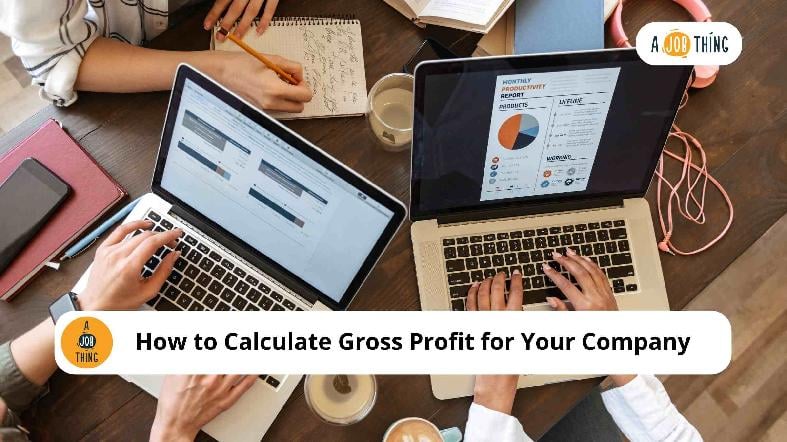
How to Calculate Gross Profit for Your Company
Are You Hiring?
Find candidates in 72 Hours with 5+ million talents in Maukerja Malaysia & Ricebowl using Job Ads.
Hire NowRunning a business is all about knowing where your money goes and more importantly, how much you’re really earning. It can be seen in gross profit.
Knowing your company's gross profit help you make smarter decisions about hiring, salary planning, and long-term strategy.
So, what is gross profit? How to calculate it? Why does it matter to you as an employer? Find out the answers in this article.
What Is Gross Profit?
Gross profit is the money a business makes after subtracting the cost of goods sold (COGS). Meaning, the direct costs involved in producing your product or delivering your service. These costs include things like raw materials, manufacturing labor, and factory expenses.
It doesn’t include other business expenses like rent, office salaries, marketing, or utilities. That comes later, when calculating net profit.
Gross profit is often called the “top-line” profit because it shows up early on your income statement. It reflects how efficiently your business turns its raw resources into sales.
Gross Profit Formula
The basic formula to calculate gross profit is:
Gross Profit = Revenue – Cost of Goods Sold (COGS)
Let’s say your company made RM100,000 in sales revenue last quarter. If your total COGS were RM60,000, your gross profit would be:
RM100,000 – RM60,000 = RM40,000
RM40,000 represents the amount you’ve earned from your products or services before incurring expenses such as office rent, admin staff, taxes, or other business costs.
What Is Included in COGS?
COGS includes direct costs such as:
-
Raw materials used in production
-
Direct labour for manufacturing (hourly workers, for example)
-
Packaging and shipping for products
-
Sales commissions or transaction fees (if tied to product delivery)
-
Equipment usage tied directly to production
It does not include indirect costs like rent, insurance, admin salaries, or marketing expenses. They are part of your operating or overhead costs, which come into play when calculating net profit.
Gross Profit vs Net Profit (What’s the Difference?)
It’s easy to confuse these two. But understanding the difference is important.
-
Gross profit looks at how much you earn from your core business after paying for production or delivery costs.
-
Net profit, also called net income, is what’s left after subtracting all expenses: COGS, salaries, utilities, taxes, interest, marketing, and more.
If gross profit tells you how efficient your production is, net profit tells you if your business is sustainable overall.
For example:
-
Revenue: RM100,000
-
COGS: RM60,000 → Gross Profit = RM40,000
-
Admin salaries, rent, marketing, tax, etc.: RM30,000 → Net Profit = RM10,000
Why It Matters for Employers & HR
If you’re in charge of payroll or hiring decisions, gross profit gives you an early signal of what’s financially possible. It can help you:
-
Decide whether your business can afford to hire more staff or give raises.
-
Plan bonuses or profit-sharing schemes in a sustainable way.
-
Compare departments or product lines, especially if some have higher production costs.
-
Track performance and adjust budgets when material or labor costs increase.
Knowing your gross profit can also help you explain budget decisions clearly to your team or leadership board.
Gross Profit Margin (Optional Extension)
To get even more insight, many employers look at the gross profit margin. It tells you how much profit you’re making on each ringgit of sales.
The formula is:
Gross Profit Margin = (Revenue – COGS) ÷ Revenue × 100
Using our earlier example:
(RM100,000 – RM60,000) ÷ RM100,000 × 100 = 40%
That means you’re keeping 40 sen for every RM1 in sales, before other business costs.
Different industries have different “good” margins, but generally, the higher the percentage, the more efficient your production.
Tips for Employers
Managing your gross profit well can help your company grow while staying financially healthy. Apply these few useful habits to build:
-
Check your gross profit regularly, especially if material prices or labor costs change.
-
Use accounting software or digital tools that can auto-calculate gross profit and margins for you.
-
Talk to your finance team before committing to big expenses like recruitment or expansions.
-
Adjust pricing or production costs if your margins start to shrink over time.
Your Next Hire Could be Just a Click Away!
At AJobThing, we connect you with 5+ million jobseekers in Malaysia, ensuring you hire the best while staying compliant with LHDN regulations.
Post your job ads today & simplify your hiring process!
Read More:
- How Businesses Register LDHN MyInvois Portal for E-Invoice
- KWSP Application Deadline 2025 for Employers in Malaysia
- 10 Types of SOCSO Claims in Malaysia (Jenis-jenis Tuntutan PERKESO)
- How to Get Ready for LHDN e-Invoicing in Your Company
- GST vs SST in Malaysia: Key Differences Every Employer Should Know
- Kenapa SOCSO Ditolak dalam Gaji? | Why is SOCSO Deducted from Salary?
- Full LHDN Stamp Duty Guide on Malaysia Employment Contract [2025]: Penalties, Exemptions, & More
- Jadual Caruman KWSP 2024/2025 (EPF Contribution Schedule)
- Pelepasan Cukai 2024/2025: Tax Reliefs Guide for Employers
- Jadual Caruman KWSP 2024/2025 (EPF Contribution Schedule)
- Fixed Deposit Rate Malaysia Calculator 2025 Guide for Employers

